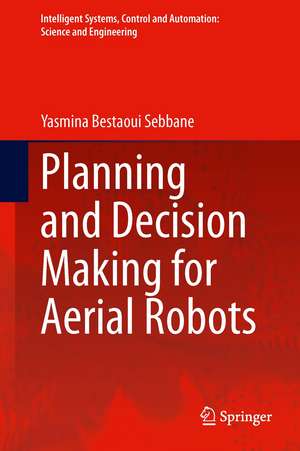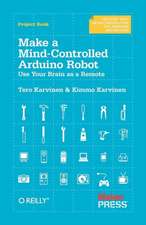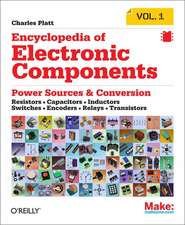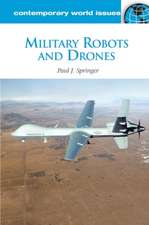Planning and Decision Making for Aerial Robots: Intelligent Systems, Control and Automation: Science and Engineering, cartea 71
Autor Yasmina Bestaoui Sebbaneen Limba Engleză Hardback – 21 ian 2014
Fundamental problems in aerial robotics include the tasks of spatial motion, spatial sensing and spatial reasoning. Reasoning in complex environments represents a difficult problem. The issues specific to spatial reasoning are planning and decision making. Planning deals with the trajectory algorithmic development based on the available information, while decision making determines priorities and evaluates potential environmental uncertainties.
The issues specific to planning and decision making for aerial robots in their environment are examined in this book and categorized as follows: motion planning, deterministic decision making, decision making under uncertainty and finally multi-robot planning. A variety of techniques are presented in this book, and a number of relevant case studies are examined. The topics considered in this book are multidisciplinary in nature and lie at the intersection of Robotics, Control Theory, Operational Research and Artificial Intelligence.
| Toate formatele și edițiile | Preț | Express |
|---|---|---|
| Paperback (1) | 646.75 lei 6-8 săpt. | |
| Springer International Publishing – 17 sep 2016 | 646.75 lei 6-8 săpt. | |
| Hardback (1) | 653.14 lei 6-8 săpt. | |
| Springer International Publishing – 21 ian 2014 | 653.14 lei 6-8 săpt. |
Din seria Intelligent Systems, Control and Automation: Science and Engineering
- 18%
 Preț: 890.23 lei
Preț: 890.23 lei - 24%
 Preț: 672.02 lei
Preț: 672.02 lei - 18%
 Preț: 951.59 lei
Preț: 951.59 lei - 15%
 Preț: 647.27 lei
Preț: 647.27 lei - 15%
 Preț: 644.63 lei
Preț: 644.63 lei - 18%
 Preț: 1246.15 lei
Preț: 1246.15 lei - 18%
 Preț: 1011.45 lei
Preț: 1011.45 lei - 20%
 Preț: 752.69 lei
Preț: 752.69 lei - 18%
 Preț: 1230.66 lei
Preț: 1230.66 lei - 18%
 Preț: 1839.32 lei
Preț: 1839.32 lei - 18%
 Preț: 719.59 lei
Preț: 719.59 lei - 15%
 Preț: 636.12 lei
Preț: 636.12 lei - 18%
 Preț: 1112.15 lei
Preț: 1112.15 lei - 18%
 Preț: 1836.31 lei
Preț: 1836.31 lei - 18%
 Preț: 1236.51 lei
Preț: 1236.51 lei - 20%
 Preț: 988.81 lei
Preț: 988.81 lei - 20%
 Preț: 357.15 lei
Preț: 357.15 lei - 15%
 Preț: 640.71 lei
Preț: 640.71 lei - 18%
 Preț: 1835.83 lei
Preț: 1835.83 lei - 18%
 Preț: 947.98 lei
Preț: 947.98 lei - 18%
 Preț: 962.98 lei
Preț: 962.98 lei - 15%
 Preț: 643.48 lei
Preț: 643.48 lei - 18%
 Preț: 951.47 lei
Preț: 951.47 lei - 18%
 Preț: 950.84 lei
Preț: 950.84 lei - 20%
 Preț: 1924.47 lei
Preț: 1924.47 lei - 15%
 Preț: 644.30 lei
Preț: 644.30 lei - 20%
 Preț: 556.65 lei
Preț: 556.65 lei - 18%
 Preț: 952.72 lei
Preț: 952.72 lei - 18%
 Preț: 953.97 lei
Preț: 953.97 lei - 18%
 Preț: 951.14 lei
Preț: 951.14 lei
Preț: 653.14 lei
Preț vechi: 768.40 lei
-15% Nou
Puncte Express: 980
Preț estimativ în valută:
124.98€ • 133.65$ • 104.20£
124.98€ • 133.65$ • 104.20£
Carte tipărită la comandă
Livrare economică 17 aprilie-01 mai
Preluare comenzi: 021 569.72.76
Specificații
ISBN-13: 9783319037066
ISBN-10: 3319037064
Pagini: 428
Ilustrații: XX, 406 p. 17 illus., 14 illus. in color.
Dimensiuni: 155 x 235 x 28 mm
Greutate: 0.77 kg
Ediția:2014
Editura: Springer International Publishing
Colecția Springer
Seria Intelligent Systems, Control and Automation: Science and Engineering
Locul publicării:Cham, Switzerland
ISBN-10: 3319037064
Pagini: 428
Ilustrații: XX, 406 p. 17 illus., 14 illus. in color.
Dimensiuni: 155 x 235 x 28 mm
Greutate: 0.77 kg
Ediția:2014
Editura: Springer International Publishing
Colecția Springer
Seria Intelligent Systems, Control and Automation: Science and Engineering
Locul publicării:Cham, Switzerland
Public țintă
ResearchCuprins
Preface.- 1 Introduction.- 2 Motion Planning.- 3 Deterministic Decision Making.- 4 Decision Making Under Uncertainty.- 5 Multi Aerial Robot Planning.- 6 General Conclusions.- Index.
Textul de pe ultima copertă
This book provides an introduction to the emerging field of planning and decision making for aerial robots. An aerial robot is the ultimate form of Unmanned Aerial Vehicle, an aircraft endowed with built-in intelligence, requiring no direct human control and able to perform a specific task. It must be able to fly within a partially structured environment, to react and adapt to changing environmental conditions and to accommodate for the uncertainty that exists in the physical world. An aerial robot can be termed as a physical agent that exists and flies in the real 3D world, can sense its environment and act on it to achieve specific goals. So throughout this book, an aerial robot will also be termed as an agent.
Fundamental problems in aerial robotics include the tasks of spatial motion, spatial sensing and spatial reasoning. Reasoning in complex environments represents a difficult problem. The issues specific to spatial reasoning are planning and decision making. Planning deals with the trajectory algorithmic development based on the available information, while decision making determines priorities and evaluates potential environmental uncertainties.
The issues specific to planning and decision making for aerial robots in their environment are examined in this book and categorized as follows: motion planning, deterministic decision making, decision making under uncertainty, and finally multi-robot planning. A variety of techniques are presented in this book, and a number of relevant case studies are examined. The topics considered in this book are multidisciplinary in nature and lie at the intersection of Robotics, Control Theory, Operational Research and Artificial Intelligence.
Fundamental problems in aerial robotics include the tasks of spatial motion, spatial sensing and spatial reasoning. Reasoning in complex environments represents a difficult problem. The issues specific to spatial reasoning are planning and decision making. Planning deals with the trajectory algorithmic development based on the available information, while decision making determines priorities and evaluates potential environmental uncertainties.
The issues specific to planning and decision making for aerial robots in their environment are examined in this book and categorized as follows: motion planning, deterministic decision making, decision making under uncertainty, and finally multi-robot planning. A variety of techniques are presented in this book, and a number of relevant case studies are examined. The topics considered in this book are multidisciplinary in nature and lie at the intersection of Robotics, Control Theory, Operational Research and Artificial Intelligence.
Caracteristici
Provides an introduction to the emerging field of planning and decision making for aerial robots Examines the issues specific to planning and decision making for aerial robots in their environment Presents a variety of techniques and developes some case studies Includes supplementary material: sn.pub/extras












